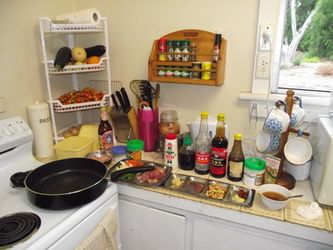|
Chilli : It is difficult to recommend how much chilli to put in any dish as everyone's taste differs. The recipes here I would regard as fairly mild to my
taste. To someone not accustomed to eating chilli they may seem medium to hot. Experiment with the amount of chilli you use to suit your own taste. The
reason I recommend Babas chilli powder is that it has great flavour and is not too hot. Some other chilli powders sold in Australia have no flavour and
are scalding hot. If you use fresh chilli instead of powder then test the chilli first by nibbling a very small piece. This will help you to determine how
hot they are.
Vegetable dishes : Many vegetable dishes in Malaysian cooking include a small amount of meat. This is usually pork or prawn and it is used to add extra flavour.
For those people who do not eat meat for one reason or another, the meat can easily be excluded from the dish. Alternately for those who do eat meat, it
is equally possible to add more meat and turn the vegetable dish into a combination meat and vegetable dish that can be served on its own with rice.
Some dishes where leaves and stems are cooked it is necessary to add the stems first to ensure they cook properly. If you add both stems and leaves at the
same time the leaves will be overcooked by the time the stems are done.
MSG : Yeah I know, everyone in the west has gone crazy about not having MSG in their food. Well in Asia it has been used and is still used in many dishes.
I cook with MSG but never more than a pinch or two. If you really don't want to use it then simply leave it out. The USA Food and Drug Administration
classifies MSG as 'generally safe' but like any food, it can have adverse reactions in a limited number of people.
Curry : There are all sorts of curry recipes but they all follow one basic rule. Unless you see a nice layer of oil come out and float on top then they are not finished.
Preparation : The real secret to making Malaysian cooking easy is your preparation. In most recipes it will be the preparation that takes more time than
the actual cooking.
Make sure you get all your ingredients out on the counter, get all your chopping, mixing and grating done before you start to cook. I have all the sauces,
powders, spices and prepared meat and vegetables lined up on the counter next to the stove. This way I don't have to go searching through the cupboards
looking for something half way through the cooking process.
Measurements : Ingredient measurements given in my recipes are a guide only. I tend to cook by taste rather than blindly following set quantities. I don't
use standard measuring spoons so a teaspoon of ingredients simply means what fits on one of my normal spoons, neither heaped or flat. The best advice I can
give to any cook is to 'taste as you go'.
Time : You will note that I rarely give any actual timed instructions for my recipes. This is because you should learn to cook using your senses to tell
you when a dish is done. Remember not to overcook vegetables but to ensure meat like chicken is always completely cooked. This is something you will learn
the more you cook.
Heat : With most dishes you start with a high heat and then after quickly stir frying for a few minutes you reduce the heat to medium. The main exceptions
to this are deep frying where a high heat is maintained thorough out and long term cooking like curries where the heat is usually medium to start with
and then turned to low and left to simmer.
|





